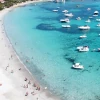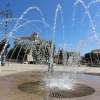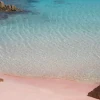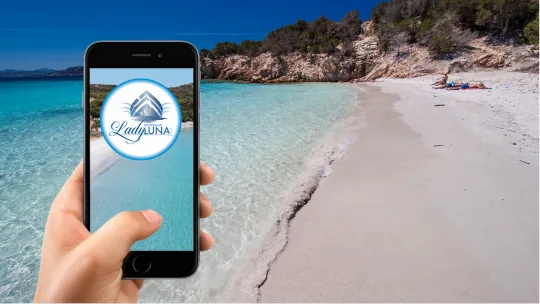Budelli Island, La Maddalena Archipelago
The tiny Budelli Island, in the La Maddalena Archipelago, has a surface area of just 1.6 sq km (0.62 sq mi), with the highest point reaching only 88 m (285 ft), while the length of the coast is 12.3 km (7.6 mi).
Located to the south of Rizzoli and Santa Maria, two other important islands in the archipelago, it is separated from them by the famous Chiecca di Morto, a stretch of sea from which it is possible to see the peaks of the main islands as well as the spectacular Strait of Bonifacio.
A natural heritage worth protecting
Reaching the island is a privilege because it means entering a unique protected nature area. This shining gem is protected by strict rules to fully preserve its landscape and natural heritage.
Beaches and landing points have long been subject to a ban on boats, bathing and reaching the beach. The Pink Beach, like the other beaches on the island, is protected by these rules, but sailing with us, on Lady Luna 3, you can admire it and experience its charm.
How to visit the Island of Budelli
Come with us to enjoy a dazzling scenery of emerald and pink hues. Step aboard Lady Luna 3, breathe in the sea air and live your dream.
Along the trip, we will visit several islands, with one of the highlights being Budelli.
The sea between La Maddalena and Budelli is truly enchanting, with the seabed alternating banks of white sand and various shades of blue, and where you will see the fish swimming in the crystal-clear water.
From the natural pools to the world-famous Pink Beach, we will take you to see the island of Budelli, a stunning protected area with spectacular scenery.
Cavaliere Beach: Budelli’s Natural Pools
Budelli has been included in the Nature Park of La Maddalena Archipelago since 2016. It is the most pristine part of the Park, as you will discover as we sail past the fine sandy coves around its 12-km coast.
Small beaches hidden by Mediterranean vegetation emerge among the granite rocks sculpted by the wind. One of these is the Cavaliere Beach, famous for the Budelli Natural Pools.
The cove has fine white sand, surrounded by rocks that take on the iridescent gold and pink hues. The sea of the small bay is of an exquisite blue colour. The name Budelli is usually associated with its Natural Pools.
The natural pools of Budelli will be our second stop, giving you a chance to have a swim and fully enjoy the surrounding scenery. A real privilege reserved for a few.
All those who have experienced dropping anchor in this cove and bathing here rank this as one of the most beautiful experiences of their life.
The Island of the Pink Beach
The most striking gem of the small island of Budelli, which has an area of about 1.60 sq km, is its Spiaggia Rosa (Pink Beach), named after the colour of its sand. This unique feature has made the beach one of the emblems of the La Maddalena Archipelago in the world.
This very rare phenomenon occurs when fragments of a microorganism, Miniacina miniacea, are dispersed in the seabed. Low-energy currents carry these fragments to the shore and deposit them, giving the beach its distinctive colour. It takes many years for the fragments to wear down to tiny particles that settle on the beach, giving it its beautiful pink colour.
Back in 1998, more than a quarter century ago, the Pink Beach was placed under strict protection to safeguard its delicate coastal environment and prevent it from being polluted or altered by visitors.
Specifically, scientific studies had shown that human presence on the beach was causing a gradual loss of the sand and erosion. Consequently, to preserve the beach, access restrictions have been put in place.
How to visit Budelli’s Pink Beach
On the boat excursion with Lady Luna 3, we will visit the island’s beauty spots, including the Pink Beach of Budelli, in Cala di Roto, on the south-eastern side of the island.
With us you can enjoy this sight, which is a privilege for a few!
What to see on Budelli Island: pristine seabed and land
Apart from its Pink Beach, Budelli is famed for its unspoilt seabed and land.
Its crystal-clear waters are home to rare species of shellfish, fish and sea creatures that few people will see with their own eyes in their lifetime. Once you dive into the water, you will find yourself in an unspoilt environment that will bring you back in time.
Budelli is also home to the archipelago’s only species of land tortoise, the Testudo marginata, and a multitude of seabirds that nest on the coast and are protected species, including the Corsican gull and the yellow-legged gull.
The fauna is characterised by the Mediterranean maquis, with juniper, mastic, rosemary and wild lavender, interspersed with rocky outcrops and filling the sea breezes with its aromatic scent.
However, no words can fully capture the beauty of this natural wonder. Budelli, together with the entire La Maddalena Archipelago, has a charm that is ultimately indescribable.
History and fun facts about Budelli
A boat excursion in the Archipelago, touching on Budelli, Spargi, Razzoli and Santa Maria, a stone’s throw from the Bonifacio Straits, is the best way to discover the rugged coastline and charming coves with crystal-clear waters. In addition to offering a sea and nature experience, the archipelago also has a rich history.
The islands of La Maddalena and its surroundings were inhabited already in prehistoric times as part of the obsidian routes, the black stone that was traded between Sardinia, Corsica and Tuscany. They were also inhabited in the Roman period.
The archipelago was later resettled in the 17th century. Its beauty makes it an ideal film set: Italian filmmaker Michelangelo Antonioni chose the Pink Beach to shoot some scenes of his 1964 film Deserto Rosso.
Once privately owned, Budelli Island was transferred to the La Maddalena Archipelago National Park in 2016.
From 1989, Budelli had just one inhabitant, who acted as the island’s guardian until 2021, when he left, leaving the island uninhabited.
When is the best time to visit the Island of Budelli?
The best time to visit the island of Budelli is from late spring to late summer.
The central summer months, July and August, provide generous sunshine and long hours of daylight, but the other months are also worth considering.
In May and June, the Mediterranean maquis is in bloom and the air smells of myrtle and juniper, while September offers a still warm sea and sunny but quieter days compared to the lively atmosphere of midsummer.
Now that you know everything about this island, all you have to do is see it with us on Lady Luna 3, to discover its natural heritage, swim in the archipelago’s sea and savour moments of relaxation.

 IT
IT  EN
EN  ES
ES  DE
DE  FR
FR 




